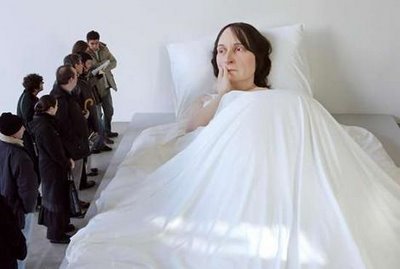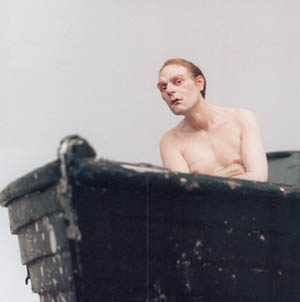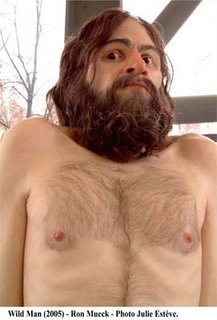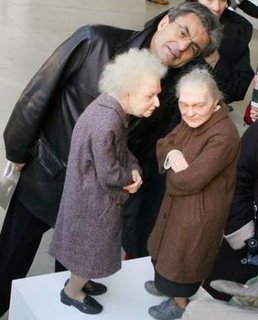 Ron Mueck
Ron MueckRoyal Scottish Academy
Edinburgh, Scotland
5 August – 9 October, 2006
Fortunately this late summer blockbuster was held over for an additional week and I didn’t miss out this time. Anyone that remembers Jim Henson’s ‘Muppets’ or the film ‘Labyrinth’ will have an immediate fondness for Mueck’s more recent creations. The hyper-realist sculptor has made a very successful transition from the world of movie and advertising animatronics to the spotlight of contemporary art. As part of the unforgettable exhibition ‘Sensation: Young British Artists from the Saatchi Collection’ that sparked controversy on three separate continents, Mueck has taken the attention he received for his small part in that show and made himself over as a main attraction. While many super star careers arose in the wake of ‘Sensation,’ this recent showcase reveals what could very well be Mueck’s greatest attempt so far at recruiting a new audience for contemporary art. Before we draw conclusions on the significance of this show, let’s consider the work.

While even the most uninitiated spectator can appreciate Mueck’s arduous quest for a pristine naturalism—this patience for representational technique remains thoroughly praiseworthy indeed, many commentators remark extensively on the careful selections that dictate the scale of these works. In my estimation, however, scale merely permits the viewer an otherwise impossible perspective, whether it be seeing that big or this small. I happen to think that Mueck simply takes his audience by the hand to a better vantage point. The more important aspect, however, is the actual site to behold. His subject matter is at once both exotic and mundane. These models could be found in the everyday if one knew exactly where to look. While these forms are not too alien to our everyday experience, what seems almost other-worldly is Mueck’s choices in posing these creatures. Rather than the idealized forms of ancient or classical sculpture, the artist has isolated and solidified the most chance appearances, looks that punctuate the visual landscape of our experience of others. These are the sort of expressions that you can miss in the real world with a mere glance or blink. They are the looks we would never model.
His subject matter is at once both exotic and mundane. These models could be found in the everyday if one knew exactly where to look. While these forms are not too alien to our everyday experience, what seems almost other-worldly is Mueck’s choices in posing these creatures. Rather than the idealized forms of ancient or classical sculpture, the artist has isolated and solidified the most chance appearances, looks that punctuate the visual landscape of our experience of others. These are the sort of expressions that you can miss in the real world with a mere glance or blink. They are the looks we would never model. 
Contrary to much of the commentary provided in the museum by the show’s organizers, the eerie candour of this work should not be interpreted too plainly or directly. While these forms are very far from idealized, they are quite recognizable. We have seen many of these expressions before… dissatisfaction, fear and frailty. They can’t hide insecurity or inadequacy any better than we. Interestingly, I found myself and those around me seemingly unable to relate to these sculptures. I know that because it seemed so natural to attempt an empathy for what we saw. I suppose that if we struggle to regard someone appearing desperate on the street we have no hope of feeling compassion for a shrunken or enlarged silicon copy in a museum. Could Mueck’s works speak beyond our spellbound voyeurism to a deeper sense, the feeling of isolation that we all experience a little bit each day? Hopefully, this vast new audience will pause in examining the subtle connections of hair and tissue and the life-like pores on Mueck’s models long enough to consider the thought. As long as most museum visitors prefer twenty foot newborns to a severed cow’s head or a shark in formaldehyde, however, it remains unlikely.
Interestingly, I found myself and those around me seemingly unable to relate to these sculptures. I know that because it seemed so natural to attempt an empathy for what we saw. I suppose that if we struggle to regard someone appearing desperate on the street we have no hope of feeling compassion for a shrunken or enlarged silicon copy in a museum. Could Mueck’s works speak beyond our spellbound voyeurism to a deeper sense, the feeling of isolation that we all experience a little bit each day? Hopefully, this vast new audience will pause in examining the subtle connections of hair and tissue and the life-like pores on Mueck’s models long enough to consider the thought. As long as most museum visitors prefer twenty foot newborns to a severed cow’s head or a shark in formaldehyde, however, it remains unlikely.

1 comment:
All Tim's g-mail friends had a thread going a while back about this artist's collection. Was it in NY for a while?
Post a Comment